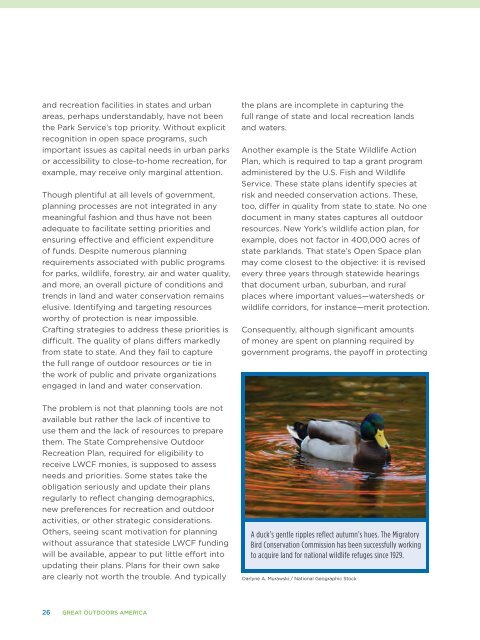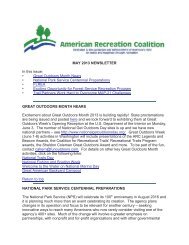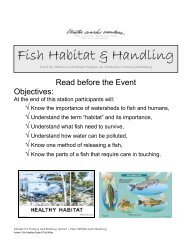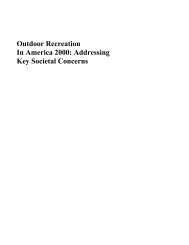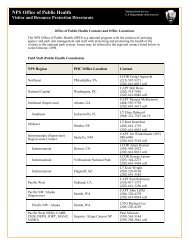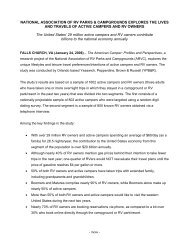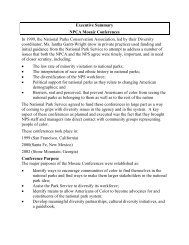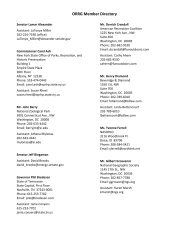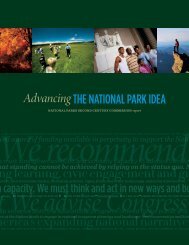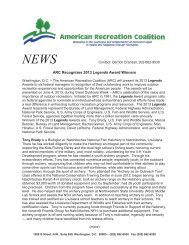Outdoor Resources Review Group Report - American Recreation ...
Outdoor Resources Review Group Report - American Recreation ...
Outdoor Resources Review Group Report - American Recreation ...
Create successful ePaper yourself
Turn your PDF publications into a flip-book with our unique Google optimized e-Paper software.
and recreation facilities in states and urban<br />
areas, perhaps understandably, have not been<br />
the Park Service’s top priority. Without explicit<br />
recognition in open space programs, such<br />
important issues as capital needs in urban parks<br />
or accessibility to close-to-home recreation, for<br />
example, may receive only marginal attention.<br />
Though plentiful at all levels of government,<br />
planning processes are not integrated in any<br />
meaningful fashion and thus have not been<br />
adequate to facilitate setting priorities and<br />
ensuring effective and efficient expenditure<br />
of funds. Despite numerous planning<br />
requirements associated with public programs<br />
for parks, wildlife, forestry, air and water quality,<br />
and more, an overall picture of conditions and<br />
trends in land and water conservation remains<br />
elusive. Identifying and targeting resources<br />
worthy of protection is near impossible.<br />
Crafting strategies to address these priorities is<br />
difficult. The quality of plans differs markedly<br />
from state to state. And they fail to capture<br />
the full range of outdoor resources or tie in<br />
the work of public and private organizations<br />
engaged in land and water conservation.<br />
The problem is not that planning tools are not<br />
available but rather the lack of incentive to<br />
use them and the lack of resources to prepare<br />
them. The State Comprehensive <strong>Outdoor</strong><br />
<strong>Recreation</strong> Plan, required for eligibility to<br />
receive LWCF monies, is supposed to assess<br />
needs and priorities. Some states take the<br />
obligation seriously and update their plans<br />
regularly to reflect changing demographics,<br />
new preferences for recreation and outdoor<br />
activities, or other strategic considerations.<br />
Others, seeing scant motivation for planning<br />
without assurance that stateside LWCF funding<br />
will be available, appear to put little effort into<br />
updating their plans. Plans for their own sake<br />
are clearly not worth the trouble. And typically<br />
26 GREAT OUTDOORS AMERICA<br />
the plans are incomplete in capturing the<br />
full range of state and local recreation lands<br />
and waters.<br />
Another example is the State Wildlife Action<br />
Plan, which is required to tap a grant program<br />
administered by the U.S. Fish and Wildlife<br />
Service. These state plans identify species at<br />
risk and needed conservation actions. These,<br />
too, differ in quality from state to state. No one<br />
document in many states captures all outdoor<br />
resources. New York’s wildlife action plan, for<br />
example, does not factor in 400,000 acres of<br />
state parklands. That state’s Open Space plan<br />
may come closest to the objective: it is revised<br />
every three years through statewide hearings<br />
that document urban, suburban, and rural<br />
places where important values—watersheds or<br />
wildlife corridors, for instance—merit protection.<br />
Consequently, although significant amounts<br />
of money are spent on planning required by<br />
government programs, the payoff in protecting<br />
A duck’s gentle ripples reflect autumn’s hues. The Migratory<br />
Bird Conservation Commission has been successfully working<br />
to acquire land for national wildlife refuges since 1929.<br />
Darlyne A. Murawski / National Geographic Stock


